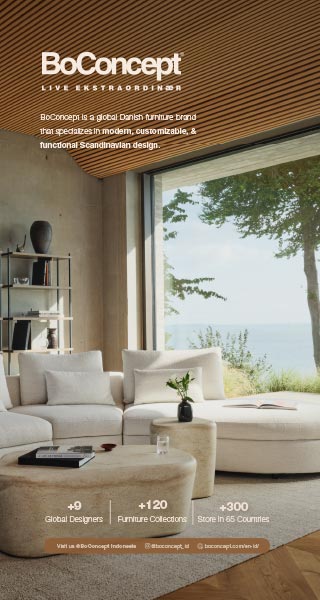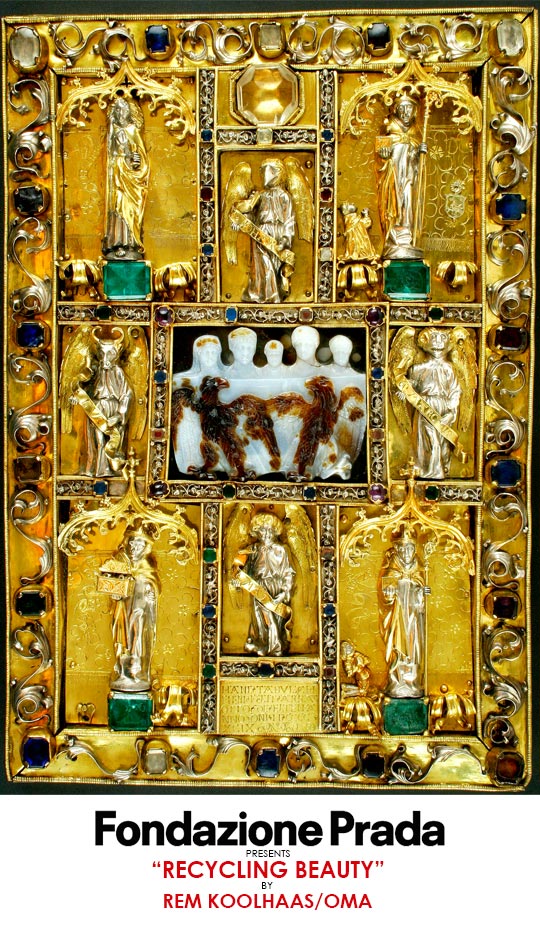
FONDAZIONE PRADA PRESENTS “RECYCLING BEAUTY” BY REM KOOLHAAS/OMA
Published by Sugar & Cream, Thursday 03 November 2022
Images courtesy of Fondazione Prada
From 17 November 2022 to 27 February 2023
“Recycling Beauty,” designed by Rem Koolhaas/OMA, is an unprecedented study dedicated entirely to the reuse of Greek and Roman antiquities in post-antique contexts, from the Middle Ages to the Baroque era.
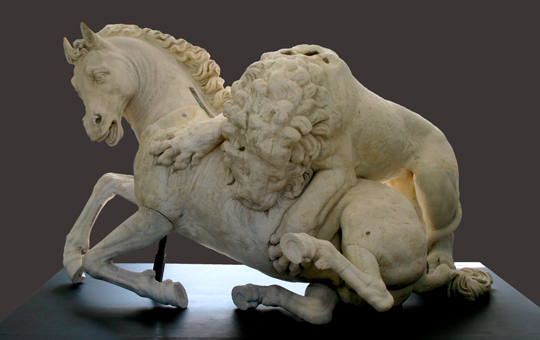
Fondazione Prada- Recycling Beauty – Gruppo di un leone che divora un cavallo
The exhibition curated by Salvatore Settis with Anna Anguissola and Denise La Monica, in its Milan venue from 17 November 2022 to 27 February 2023.
The exhibition is part of a broader investigation undertaken by Fondazione Prada since 2015, when it simultaneously presented “Serial Classic” and “Portable Classic” in its Milan and Venice spaces, two exhibitions curated by Salvatore Settis (with Anna Anguissola in Milan, and Davide Gasparotto in Venice) and designed by Rem Koolhaas/OMA. The underlying premise of this research is the need to think of the classical not simply as a legacy of the past, but also as a vital element with the power to affect our present and future. Such themes as seriality, reuse, and recycling in art are closely linked to our conception of modernity, but they also attest to the extraordinary persistence of certain classical values, categories, and models. Through an innovative interpretive approach and experimental exhibition formats, ancient heritage—in particular Greco-Roman heritage—becomes, in Settis’ words, “a key that provides access to the multiplicity of cultures in the contemporary world.”
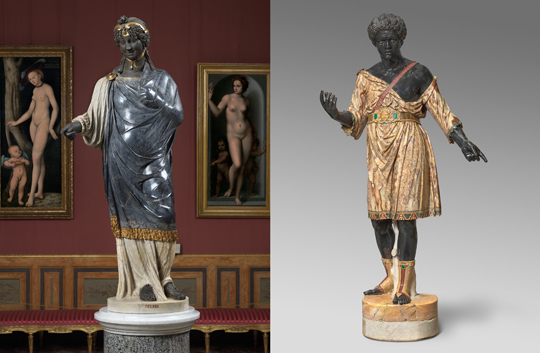
Fondazione Prada – Recycling Beauty – La Zingarella e Moro Borghese
Despite its cultural relevance and widespread diffusion, the reuse of ancient materials has been studied in depth only recently. In the last few years detailed attention has been devoted to the essential aspect of this phenomenon: the visual and conceptual interaction between the reused ancient elements and the post-Antique context, far from their origin, they became part of. “Recycling Beauty,” instead, aims to draw attention to the moment when an antique artifact crosses the boundary between its condition of abandonment among ruins and the moment its value is reactivated through its reuse. Each recycled piece thus transforms its new context and is in turn transformed by it, in keeping with an intertextual mechanism of mutual legitimation and attribution of meaning. Exploring the fluidity of meaning of art objects that in time shift their use, reception, and interpretation means to reflect on the unstable and transformative nature of artistic processes.
As Salvatore Settis explains, “Reuse entails the coexistence of different temporalities, in which historical distance and narrative and emotional simultaneity are continually intertwined. The ancient Roman marbles belong to the same cultural horizon as those who reuse them, therefore appropriating them is felt to be natural. But the dimension of time evades the sequence of the calendar: it is unstable and can be manipulated and bent […]. Why take from ruins a relief, a vase, a capital? Why carry it somewhere else to insert it into a new context? The answers explored in recent decades go in three complementary directions: reuse can have a value that is either memorial (aimed at the past), foundational (directed towards the present), or predictive (oriented towards the future). Without documents it is often difficult to decide which of these intents prevailed from one case to the next; it is certainly possible that they were present simultaneously. […] The heart and spur of the act of reuse is often, or maybe always, ‘to insert the past into the future,’ as German historian Reinhart Koselleck contends to foresee or determine its development. The new context absorbs what it reuses, but it must (and wants to) leave it recognizable even while (or rather, precisely because) it takes possession of it.”
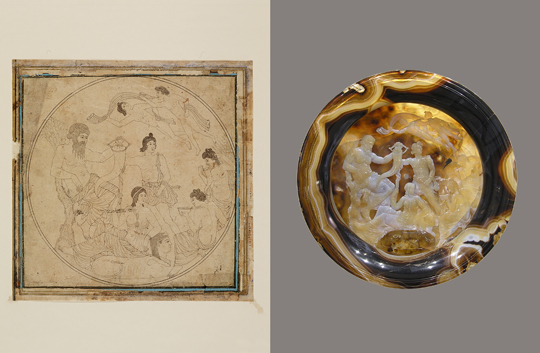
Fondazione Prada – Recycling Beauty – Tazza Farnese
The exhibition design, conceived by Rem Koolhaas/OMA, together with Giulio Margheri, takes place in two of Fondazione Prada’s buildings—the Podium and the Cisterna—as a process of historical analysis, discovery, and imagination. The scenography in the Podium invites visitors to engage with the exhibits at different speeds. A landscape of low-rise plinths made of acrylic allows for the pieces on display to be perceived as an ensemble, while the cubicle-like structures encourage a closer examination with the presence of office chairs. In the Cisterna, visitors encounter the exhibits gradually, in a sequence of spaces that facilitate observation at different points of view from the height of a balcony to the confined perspective of a room built inside one of the existing rooms. Parts of the design come from materials from previous exhibitions hosted at Fondazione Prada—the acrylic bases were first used in 2015 for “Serial Classic”, adding a spatial dimension to the theme of “Recycling Beauty.”
The installation aims to underline the great artistic and historical value of the works presented, but also to demonstrate how they have experienced migration, transformation, and evolutions of meaning. Highlighting the importance of fragments, reuse, and interpretation, the exhibition design helps to consider the past as an unstable phenomenon in constant evolution. This layered path houses over fifty highly representative artworks from international and Italian public collections and museums, including Musée du Louvre in Paris, Kunsthistorisches Museum in Vienna, Ny Carlsberg Glyptotek in Copenhagen, Musei Capitolini, Musei Vaticani, and Galleria Borghese in Rome, Gallerie degli Uffizi in Florence, and Museo Archeologico Nazionale in Naples.
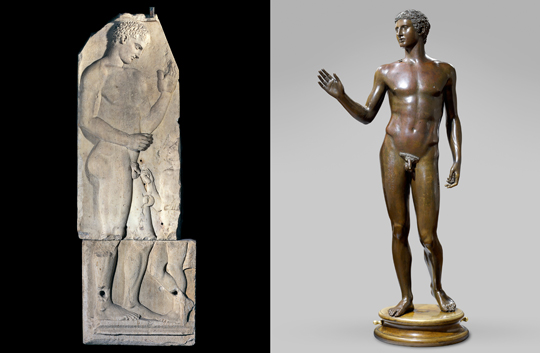
Fondazione Prada – Recycling Beauty – Stele funeraria di Palestrina
Although Rome’s immense ruins shattered to pieces within a few generations after the collapse of the Western Roman Empire, their remnants were considered as a vast repertoire of materials able to preserve and revitalize latent values and symbols of antiquity. Two rooms in the Cisterna are dedicated to the colossal statue of Constantine (4th century CE), one of the most important works of late ancient Roman sculpture. Two monumental marble fragments, the right hand and foot—normally displayed in the courtyard of the Palazzo dei Conservatori in Rome—are placed alongside a full-scale reconstruction of the Colossus. Something that has never been attempted before, this demonstrates how the statue was the outcome of the reworking of an earlier cult statue, probably of Jupiter. This project is the result of collaboration between the Musei Capitolini, Fondazione Prada, and Factum Foundation, with the scientific supervision directed by Claudio Parisi Presicce, the Capitoline Superintendent of Cultural Heritage. After the exhibition, the Colossus will be displayed at the Musei Capitolini.

Presented by Zipblind
Another group of works reflects on how the transformation of ancient pieces into decorative elements, despite harming their physical integrity and original setting, paradoxically ensured their preservation. Two examples are the marble mensa embellished with a relief of Achilles’ life (4th century CE) and Cosmatesque decoration (13th century) that adorned the ambo of Santa Maria in Aracoeli from the 13th century to 1743, and the Dionysian marble krater (1st century BCE) carved by the Athenian sculptor Salpion and reused as a baptismal font in Gaeta Cathedral.
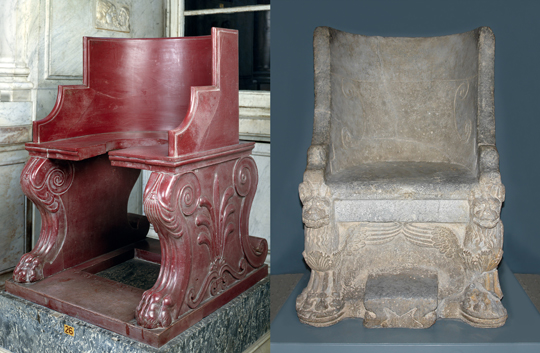
Fondazione Prada – Recycling Beauty – Sedia e Trono
Certain works in the exhibition investigate the functional, political or religious reasons for the reuse of antique artifacts, even though the original meaning of the reused objects was almost never understood. One such case is the Hellenistic-age sculptural group A Lion Attacking a Horse (4th century BCE), which in the Middle Ages was placed on the Capitoline Hill and became an allegory of good city government. Other examples are given by the reuse of ancient tomb monuments decorated with mythical scenes that no one was able to ‘read’ anymore, except as generic evidence of the greatness of a vanished empire or the defeat of paganism. These include a Dionysian sarcophagus from Cortona (2nd century CE), which was reused in 1247 as a tomb for the Blessed Guido Vagnottelli, and an Etruscan urn (2nd century BCE) that was recycled in Pistoia in the 12th century to hold the relics of Saint Felix, though the representation that celebrated the founding myth of the Olympiads was not recognized.
The semantic instability of reused ancient artifacts, or rather their continuous mutation of meaning, is illustrated in the exhibition by a funerary relief (1st century CE) that was once displayed on the façade of Casa Santacroce in Rome. Inscriptions added in the 15th century interpret the figures of the deceased as Honor, Amor, and Veritas. Incorporating this relief into a new context meant not only paying tribute to Roman art, but above all transforming the ancient image into a modern model of moral conduct. This same principle was followed in the 15th century by whoever installed seven ancient male heads sculpted in marble on the façade of Palazzo Trinci in Foligno, transforming them into an allegory of the Seven Ages of Man.
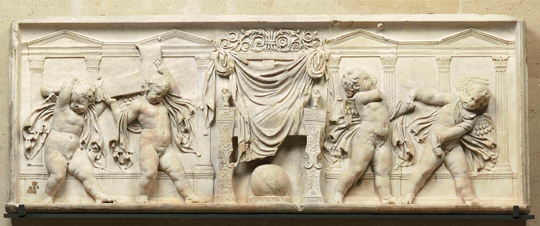
Fondazione Prada – Recycling Beauty – Frammento di rilievo con il Trono di Saturno
Other works exhibited in “Recycling Beauty” relate the rediscovery or rebirth of ancient artifacts which, having been part of forgotten ruins or neglected elements of the past, became prestigious collectibles, thus initiating a twin process of dispersal and concentration. This is what happened on two occasions to the funerary “stele of an athlete” (450–430 BCE), in which we see the figures of an athlete and his servant. The stele arrived in ancient Rome from Greece as a collector’s object, then reappeared in the collection of a cardinal during the early 16th century, but in 1701 was cut into two pieces and obliterated, before finally being reassembled at the Musei Vaticani in 1957. An even more intricate history, bound up with the birth of antiquities collection, is that of the thirteen sculptural fragments of the Thrones of Ravenna. These are all that remain of twenty-four carved slabs datable to the mid-1st century CE that depicted the empty thrones of the twenty-four deities expected at a banquet: this theme of remote Mesopotamian origin would later be taken up in Christian and Buddhist iconography. Beginning in the 12th century, some of the reliefs began to circulate in small Italian towns (Biella, Treviso, Foligno), and only later in such major art cities as Venice, Florence, Rome, Milan, Fontainebleau, and then Paris. For the first time, “Recycling Beauty” shows all the surviving reliefs together, either the originals or (in the few cases of impossibility to move them) in the form of casts.
Another set of exhibited works explores the short-circuit sparked between different temporalities when art objects are mistaken for antiquities, despite being from the Modern age. One famous example, shown in the exhibition, is the marvelous horse’s head created by Donatello in the mid-15th century for the arch in the Castel Nuovo in Naples, which until a little over twenty years ago was thought to be of Greco-Roman origin. More research conducted for “Recycling Beauty” later showed that the statue said to be “of Paris,” which formerly stood on a spire in Milan Cathedral and was believed to have been made in the Roman age, should instead be dated to the 16th century.
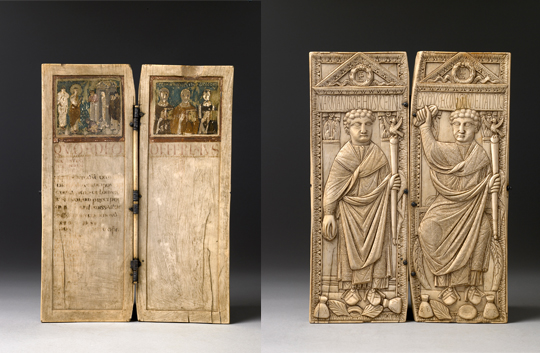
Fondazione Prada – Recycling Beauty – Dittico consolare di Manlio Boezio & Dittico consolare di Manlio Boezio
In the vast process of destruction and gradual oblivion of much of Greco-Roman art, only objects considered particularly valuable have often been saved. Among these, the show displays the bronze statue of a Camillus (1st century CE) donated to the City of Rome by Sixtus IV in 1471, and a pair of Baroque works, The ‘Borghese Moor,’ and Gypsy Girl, both of which were reassembled in Rome by French sculptor Nicolas Cordier by combining ancient fragments with parts of his own creation. These two statues were both in the collection of Cardinal Scipione Borghese from the early 17th century, while today The Moor is at the Musée du Louvre in Paris and the Gypsy Girl at the Galleria Borghese in Rome.
Other objects in the exhibition can be regarded as real treasures that have resisted the ravages of time. One such case is the Farnese Cup (2nd-1st century BCE), the largest hardstone cameo that has come down to us from antiquity. This Hellenistic artifact, extraordinary in material, technique, and size, was passed from court to court, crossing great geographic distances from Egypt to Rome and Byzantium, then to Persia and back to the West, moving between some of the most important collections of antiquities of the Middle and Modern ages, including those of Frederick II and Lorenzo the Magnificent.
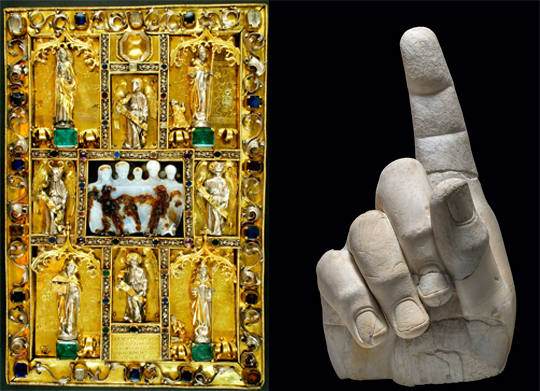
Fondazione Prada – Recycling Beauty – Coperta dell’Evangeliario di Ada & Mano destra del Colosso di Costantino
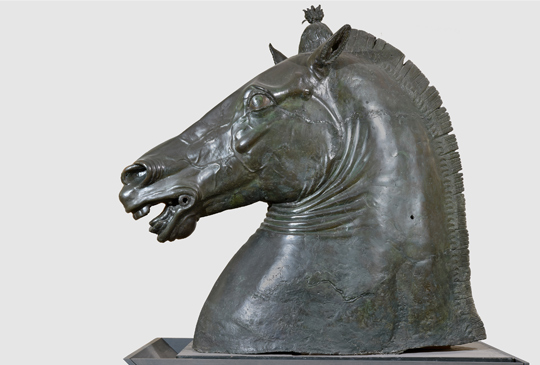
Fondazione Prada – Recycling Beauty – Testa Carafa
On the occasion of the “Recycling Beauty” exhibition, Fondazione Prada created an extensive illustrated volume. A visual essay, sixteen critical texts, four in-depth studies, and a comprehensive series of detailed profiles of the exhibited objects analyze the theme of reuse in art and architecture from different historical, artistic, and philosophical perspectives, with the aim of outlining a history and recognizing the continuity or the conformity of these practices with the thinking and experiments of the present day.
 7.38K
30/12/2025
7.38K
30/12/2025
FRAG UNVEILS A NEW CHAPTER IN MATERIAL-DRIVEN DESIGN
in 2025 FRAG unveils a new chapter in material-driven design: a collection that deepens its enduring dialogue with materials.
read more 4.04K
29/12/2025
4.04K
29/12/2025
CHANEL HOLIDAY 2025 — FESTIVE GIFT GUIDE SEASON
CHANEL Holiday 2025 unveils luminous icons and sensorial treasures to brighten this festive season for you!
read more 11.03K
03/12/2025
11.03K
03/12/2025
LIVING DIVANI ILLUMINATES THE FESTIVE SEASON IN SHADES OF DEEP RED AND LUMINOUS SILVER
Living Divani illuminates the festive season in shades of deep red and luminous silver, reimagining its iconic designs with festive radiance.”
read more 10.32K
15/12/2025
10.32K
15/12/2025
CIERRE1972 PRESENTS BELT AND MAC: TWO ARMCHAIRS DEFINED BY CONTEMPORARY ELEGANCE
Cierre1972’s Dynamic Duo, Defined by Contemporary Elegance
read more 81.74K
10/01/2025
81.74K
10/01/2025
W RESIDENCE IN SOUTH JAKARTA BY MICHAEL CHANDRA
Michael Chandra, founder of MNCO Studio Design has created the W Residence with an aesthetically pleasing, practical, and pleasant home from all...
read more 44.47K
11/07/2025
44.47K
11/07/2025
PELUNCURAN PERDANA LEGANO HOME MENGGANDENG AGAM RIADI DI ST REGIS RESIDENCE JAKARTA
Peluncuran perdana LEGANO HOME menggandeng Agam Riadi di St. Regis Residence Jakarta: menyatukan kemewahan dan jiwa dalam sebuah ruang.
read more





